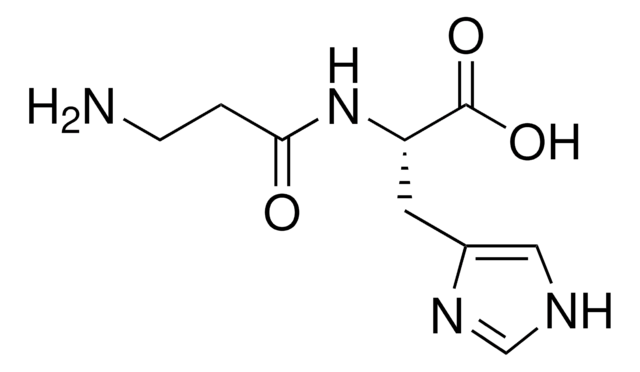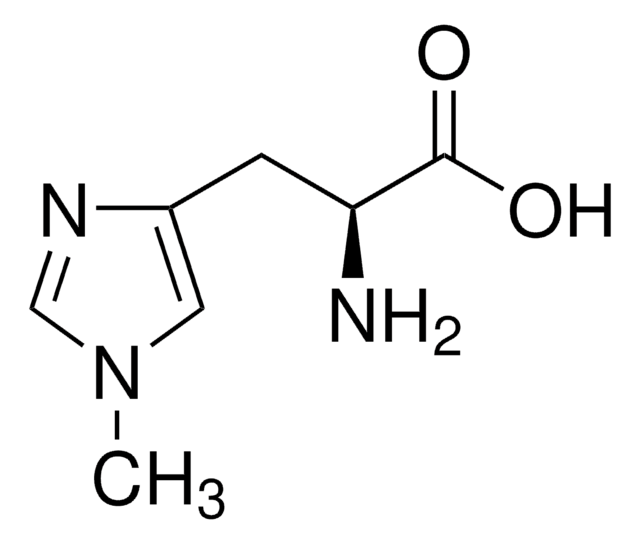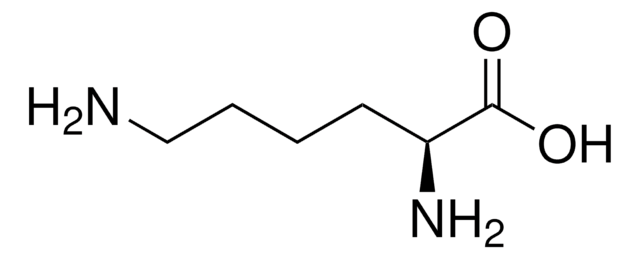E8399
Eotaxin-3 human
>97% (SDS-PAGE), recombinant, expressed in E. coli, lyophilized powder, suitable for cell culture
Sinónimos:
CCL26, SCYA26
Iniciar sesiónpara Ver la Fijación de precios por contrato y de la organización
About This Item
Productos recomendados
biological source
human
Quality Level
recombinant
expressed in E. coli
assay
>97% (SDS-PAGE)
form
lyophilized powder
potency
0.25-1.0 mg
mol wt
~8.2 kDa
packaging
pkg of 25 μg
storage condition
avoid repeated freeze/thaw cycles
technique(s)
cell culture | mammalian: suitable
impurities
endotoxin, tested
UniProt accession no.
storage temp.
−20°C
Gene Information
human ... CCL26(10344)
General description
Eotaxin-3, also known as CCL26 or SCYA26, is a human CC chemokine and a functional ligand for CC chemokine receptor 3. This gene is localized to human chromosome 7q11.2, which codes for a protein of 71 amino acids. It belongs to the small inducible cytokine subfamily A , which also includes eotaxin and eotaxin-2.
Biochem/physiol Actions
Also known as CCL26 or SCYA26; a human CC chemokine and a functional ligand for CC chemokine receptor 3; mature recombinant human eotaxin-3 demonstrates chemotactic activity for eosinophils.
Eotaxin-3 is a potent attractant of eosinophils, and might be responsible for the accumulation of eosinophils in atopic diseases. As it is involved in the recruitment of eosinophils in inflammatory diseases, it, along with its receptor, might have potential as therapeutic target in inflammatory disorders, such as asthma. Demethylation results in increased expression of this gene, which in turn influences allergic reactions. This gene is overexpressed in bullous pemphigoid (BP), which results in the accumulation of eosinophils in skin lesions, thus, contributing to the pathogenesis of BP. Its expression is also elevated in the active lesions of patients with ulcerative colitis (UC) and Crohn′s disease (CD). Thus, it might play a role in the pathogenesis of UC, where its major source is colonic myofibroblasts.
Eotaxin-3, also known as CCL26 or SCYA26, is a human CC chemokine and a functional ligand for CC chemokine receptor 3. Mature recombinant human eotaxin-3 has a molecular mass of approximately 8.2 kDa and demonstrates chemotactic activity for eosinophils.
Physical form
Lyophilized from a 0.2 μm filtered solution in 30% acetonitrile and 0.1% trifluoroacetic acid containing 1.25 mg bovine serum albumin.
Analysis Note
The biological activity is measured by its ability to induce chemotaxis of rat Y3 cells stably expressing hCCR3.
signalword
Warning
hcodes
Hazard Classifications
Acute Tox. 4 Inhalation - Eye Irrit. 2
Storage Class
11 - Combustible Solids
wgk_germany
WGK 2
flash_point_f
Not applicable
flash_point_c
Not applicable
Elija entre una de las versiones más recientes:
¿Ya tiene este producto?
Encuentre la documentación para los productos que ha comprado recientemente en la Biblioteca de documentos.
Eunjin Lim et al.
Journal of immunology (Baltimore, Md. : 1950), 192(1), 466-474 (2013-12-11)
DNA demethylation has been primarily studied in the context of development biology, cell fate, and cancer, with less attention on inflammation. In this article, we investigate the association between DNA methylation and production of the chemoattractant cytokine eotaxin-3 in the
M Kitaura et al.
The Journal of biological chemistry, 274(39), 27975-27980 (1999-09-17)
Previously, we mapped the novel CC chemokine myeloid progenitor inhibitory factor 2 (MPIF-2)/eotaxin-2 to chromosome 7q11.23 (Nomiyama, H., Osborne, L. R., Imai, T., Kusuda, J., Miura, R., Tsui, L.-C., and Yoshie, O. (1998) Genomics 49, 339-340). Since chemokine genes tend
C Günther et al.
Clinical and experimental immunology, 166(2), 145-153 (2011-10-12)
Eosinophils contribute to the pathogenesis of bullous pemphigoid (BP) by secretion of proinflammatory cytokines and proteases. Trafficking of eosinophils into tissue in animal models and asthma depends on interleukin-5 and a family of chemokines named eotaxins, comprising CCL11, CCL24 and
R F Guo et al.
Genomics, 58(3), 313-317 (1999-06-22)
By searching the Expressed Sequence Tag database, a full-length cDNA for a novel human CC chemokine was cloned. This cDNA encoded a 94-amino-acid protein with a putative signal peptide of 26 amino acids. The deduced mature protein had the four
A Shinkai et al.
Journal of immunology (Baltimore, Md. : 1950), 163(3), 1602-1610 (1999-07-22)
IL-4 has been shown to be involved in the accumulation of leukocytes, especially eosinophils, at sites of inflammation by acting on vascular endothelial cells. To identify novel molecules involved in the IL-4-dependent eosinophil extravasation, cDNA prepared from HUVEC stimulated with
Nuestro equipo de científicos tiene experiencia en todas las áreas de investigación: Ciencias de la vida, Ciencia de los materiales, Síntesis química, Cromatografía, Analítica y muchas otras.
Póngase en contacto con el Servicio técnico






